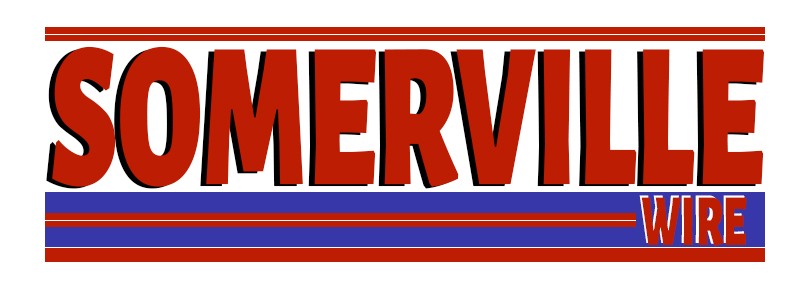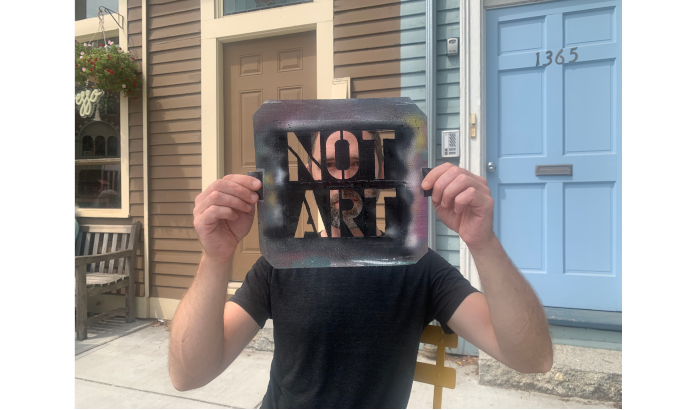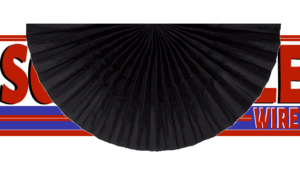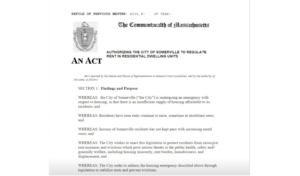(Somerville Wire) – Letting your eyes go astray around the nooks and crannies of Somerville’s urban center, one might notice the spray-painted words “NOT ART.”
It’s on bits of debris, highway barriers, road signs, neglected objects—so ubiquitous that this reporter walked right over a “tag” on the way to meet the artist himself. The faded black letters were on the sidewalk, painted on what appeared to be bits of paper mixed with dried plaster.
The art occupies “interstitial spaces” the artist said, “where people don’t tend to pay attention.” But fifteen years since spraying his first NOT ART stencil, the artist’s work has garnered the attention of thousands of Somerville residents and passersby.
The creator of NOT ART wished to remain anonymous, but was eager to share his story about how explorations in artistic disillusion and paradox ultimately created a path to self-affirmation.
“I knew I was an artist because I’ve always made art. I was the kid drawing in class, listening to grunge music—I didn’t get sports,” the artist told me, sitting near a window at Cafe 1369 in Inman Square.
“I dropped out of Oberlin College after failing out because of depression… One winter in Cape Cod was enough to convince me to move to Boston. I immediately loved the city, attending shows at The Middle East and doing assemblage and collage work. I had a couple shows at Zeitgeist and Out of the Blue, but I didn’t feel confident about them. Nothing sold and every show felt like I was preaching to the choir.”
Before long, the artist fell out of the gallery scene. Older artists with more confidence and self identities did well in the showcasing environment—they were able to pony up to the expectations of audiences and seemed fulfilled by the formalities of the process. This artist was in need of something more spontaneous.
“I was working at this upscale place in Central Square called Rendezvous. I was a food runner there. My coworkers were older, mostly artists, and I looked up to them. One day, I decided to bring in a piece of my artwork—this was before cell phones were taking pictures of things,” he clarified.
“I had made this small wooden box that I completely burned, then placed a rock, a little bottle, and a feather in it … Kind of weird and creepy, but totally me. I left it at the waiter’s station during a rush and at the end of the night, I called everyone together and said, ‘I want to show y’all my artwork.’ And one woman said, ‘that’s art? I thought something was going to jump out at me.’”
The artist was hooked. “It was crazy. Her enthusiasm, it was cool. I had never had someone show enthusiasm like that. A second guy, who was always very quiet, a bit of a weird guy, said, ‘I saw that and thought it was a Native American face-painting kit.’ And I was like what the fuck?”
The artist had gotten a reaction and he wanted to reproduce it. “At one point I said to one of my friends, what if I just don’t make art? And my friend rolled her eyes. I pitched the idea to another friend and fellow artist who admired my work at the time—she hated it. Many people hated NOT ART when it started,” the artist said, noting a few run-ins with the police.
Encouraged by the opposition to his project, the artist decided to not make art and become the authority on what is art, by destabilizing any static definition on the matter. And because the NOT ART artist has bipolar disorder, that made perfect (non)sense.
“A lot of my desire to make art was to heal my mind from bipolar disorder. For a while I ignored therapists. I’ve hit my head on the wall by thinking about things. I love the process of analysis. I think my obsession and self-reflection stems from a need to self-actualize in my environment. But any mode of inquiry requires us to accept a certain degree of paradox,” he said.
For NOT ART, the artist embraced the Liar’s Paradox: any statement that when analyzed, leads to a logical contradiction. For example, “this sentence is false.” It’s a trick or a knot, (take your pick) of self-referentiality. And artists have used it before. (See “The Treachery of Images” by René Magritte).
Aside from the project’s artistic merits and philosophical roots, the paradoxical NOT ART tag has been a tool and a refuge for an artist feeling trapped by the “black and white thought” of pragmatic life. That something can and can’t be art was a comforting negation of the philosophical monism that had once made the artist feel trapped. It opened the doors to pluralism—NOT ART was free to interpretation.
“[NOT ART] is a vehicle for inquiry. It’s a vehicle to empower people to think outside the box and to stop and trust their own judgment. It’s a catalyst of sorts. I’m not trying to make it more than what it is, because I already did.”
Today, the NOT ART artist said he feels comfortable in his identity. He doesn’t need NOT ART anymore, but continues the work in light of what it provides other people.
“I was socially alienated through much of my life. I was looking for something that was next level, which I found with NOT ART…That provided a way to connect with people,” he said. And it enabled the artist to unearth the shared meaning-making process behind art and language as a whole.
“Everyone has different theories about what it means. Some take it literally, others metaphorically; people have even come to me with conspiracy theories,” he said laughing.
“It’s a lot of fun. The last time I could say that was when I was five years old. I feel incredible and immense gratitude for being okay. I’ve wanted to tell people what I’m going through but was unable to say it until those two words.”
“And am I under some spell?
And do my thoughts belong to me?
Or just some slogan I ingested to save time?
This night is missing people”
– Parquet Courts, Content Nausea
“In semiotics, signified and signifier (French: signifié and signifiant) stand for the two main components of a sign, where signified pertains to the “plane of content”, while signifier is the “plane of expression”. The idea was first proposed in the work of Swiss linguist Ferdinand de Saussure, one of the two founders of semiotics.”
– Wikipedia, content nausea
“Michel de Certeau, in his The Practice of Everyday Life: signifiers and referents are easily conflated in a society that contains so many coherent texts. The coherence is de Certeau’s key point: the power to define comes from a multiplicity of signifiers that all point to the same referent. There is only one paradigm (for the most part) for ideas like beauty or age in popular media because there is power in a coherent network of meaning and representation. De Certeau claims that it is the constant onslaught of different texts – magazines, billboards, TV – with similar signifiers for beauty, age, gender, etc. that drives the myths surrounding those norms.”
– Joukowsky Institute at Brown University, content nausea institutionalized
This article is syndicated by the Somerville Wire municipal news service—a project of the IRS 501(c)(3) tax-deductible nonprofit Somerville Media Fund.
All Somerville Wire articles may be republished by community news outlets free of charge with permission and by larger commercial news outlets for a fee. Republication requests and all other inquiries should be directed to somervillewire@somervillemedia.fund.
SUBSCRIBE TO THE SOMERVILLE WIRE EMAIL NEWSLETTER: http://eepurl.com/hX3alr
Check out all our social media here: https://linktr.ee/SomervilleWire.
Ryan DiLello is the staff reporter for the Somerville Wire





